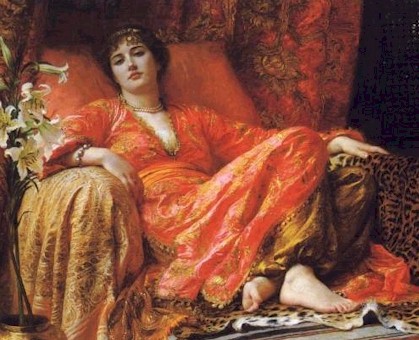Most people know the lady and courtesan, Kamala, from Herman Hesse’s classic spiritual novel, Siddhartha. Not only did she master the art of poetry, music, dance and philosophy, but also the art of making love. Kamala’s flamboyant and erotic skills were not something to be sold, but were part of her repertoire as a teacher from whom a supplicant could receive lessons. Her life example playfully demonstrates independence, dignity and a cultured personality.

The sixty-four arts of making love all had to be mastered, and would define a cultured courtesan . These arts are described in the various versions of Kamasutra, and in The Perfumed Garden Sir Richard Burton gives a rare glimpse into this culture. The courtesans also mastered many other artistic disciplines including tailoring, fine carpentry, rules of architecture, chemistry, mineralogy, laws of society, how to pay respect and make compliments, singing, playing a musical instrument, dancing, writing, reading the thoughts of others, the art of attracting and captivating the mind of others, magic, manufacturing scents and garlands, drawing, sculpturing and painting. They were often more artists and teachers than we tend to believe. It is within this context we can understand the courtesans of ancient India.
One outstanding example is Lady Purasati. She was a courtesan as well as a realized master and lineage holder of the Mahasandhi instructions, a tradition that did not discriminate between cast, gender or age. The only qualification was realization. She attained accomplishment through the practice of Vajra Tikshana, the embodiment of transcendental knowledge. Having received instruction from an Indian rishi by the name Bhashita, she practiced one-pointedly and became so stable in awakened mind, that she is counted among the teachers of the philosopher Nagarjuna, whose short and clear tracts on knowing reality are still used today because of their invincibility. It’s a shame that we don’t know more about her besides her poetry. Here is one her songs of realization.
Another sweet example is Barani the Courtesan. The ancient texts mention that she was a daughter of the commoner Rahuta and his wife Joyful Dhari. Her mind was bright and sharp with the Mahayana potential. She requested the meaning of the realized state from her teacher, the lady Bodhi the Yakshini, who then bestowed it in full and condensed the meaning for her in a song:
Buddhas and all beings are no different from the first;
Realize this fact, the state sublime.
Once you realize nondual mind to be the dharmakaya,
Apart from this there is no higher training.
The courtesan understood the basic intent and then expressed her realization:
I am Barani the Courtesan
Who fully sees awakened mind, the sovereign of every view.
Mind is neither male nor female, so union I fear not.
Mind knows neither birth nor death, it does not die by slaying.
Worlds and beings are all nectar, timelessly transcending unclean and the clean.
It was around that time Bhibhi Rahula, the king of Kashmir, and his wife Shila Kumara had a son who was later known as Brilliance, the Kashmiri scholar. He became a pandita of the most erudite learning, and requested the meaning of the realized state from Barani the Courtesan, which she bestowed in full and then condensed the meaning for him in song:
Awakened mind is the fruition resulting from no cause.
Awakened mind is the instruction that does not come from words.
Awakened mind is the buddha who does not stem from thought.
Like space, awakened mind is not a thing that can be seen.
Devoid of color, it is not a thing to be singled out as this.
Within the gigantic web of illusion, the mahamaya of human culture on our blue planet, women of wisdom and artistic talents have often been ignored. In a perfect world everyone deserves equal respect.
Source: Wellsprings of the Great Perfection by Erik Pema Kunsang.
Artwork by
